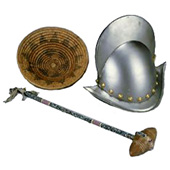Grand Junction History
 While our timeline begins in the 1880s when Grand Junction was founded, the region has a history well beyond that of Grand Junction. Traces of Paleo Indians in Mesa County date to 11,000 B.C.E., and Archaic Indians to 8,000 B.C.E. Fremont Indians were here about 700 to 1200 C.E. Additionally, the Ute people occupied territory in Colorado and Utah well before Spanish padres, mountain men, and surveyors came to explore and record the region. Colorado became the Centennial State in 1876. Three years later, an Indian uprising near Meeker led to the removal of Ute Indians from the northern two-thirds of Western Colorado to reservations in Utah. White settlers arrived in Mesa County in 1881.
While our timeline begins in the 1880s when Grand Junction was founded, the region has a history well beyond that of Grand Junction. Traces of Paleo Indians in Mesa County date to 11,000 B.C.E., and Archaic Indians to 8,000 B.C.E. Fremont Indians were here about 700 to 1200 C.E. Additionally, the Ute people occupied territory in Colorado and Utah well before Spanish padres, mountain men, and surveyors came to explore and record the region. Colorado became the Centennial State in 1876. Three years later, an Indian uprising near Meeker led to the removal of Ute Indians from the northern two-thirds of Western Colorado to reservations in Utah. White settlers arrived in Mesa County in 1881.
